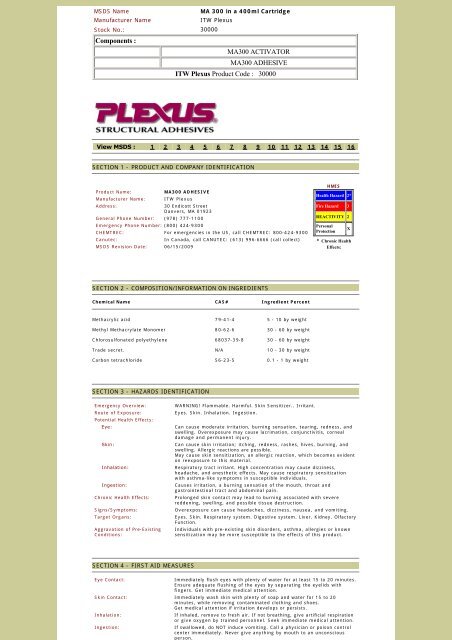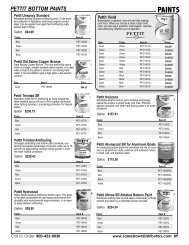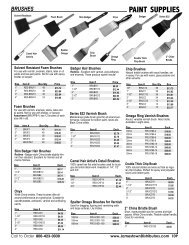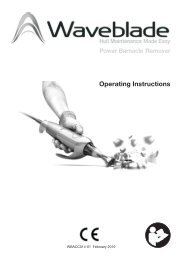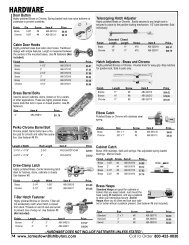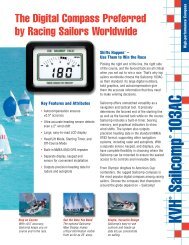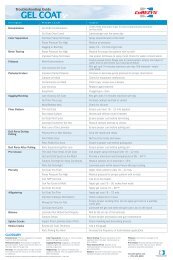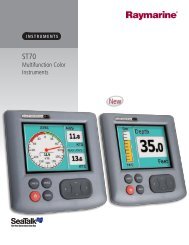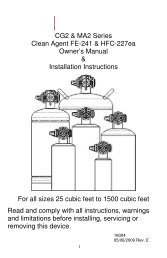MSDS Plexus MA300 Adhesive - Jamestown Distributors
MSDS Plexus MA300 Adhesive - Jamestown Distributors
MSDS Plexus MA300 Adhesive - Jamestown Distributors
You also want an ePaper? Increase the reach of your titles
YUMPU automatically turns print PDFs into web optimized ePapers that Google loves.
<strong>MSDS</strong> Name<br />
MA 300 in a 400ml Cartridge<br />
Manufacturer Name<br />
ITW <strong>Plexus</strong><br />
Stock No.: 30000<br />
Components :<br />
<strong>MA300</strong> ACTIVATOR<br />
<strong>MA300</strong> ADHESIVE<br />
ITW <strong>Plexus</strong> Product Code : 30000<br />
View <strong>MSDS</strong> : 1 2 3 4 5 6 7 8 9 10 11 12 13 14 15 16<br />
SECTION 1 - PRODUCT AND COMPANY IDENTIFICATION<br />
Product Name:<br />
Manufacturer Name:<br />
Address:<br />
<strong>MA300</strong> ADHESIVE<br />
ITW <strong>Plexus</strong><br />
30 Endicott Street<br />
Danvers, MA 01923<br />
General Phone Number: (978) 777-1100<br />
Emergency Phone Number: (800) 424-9300<br />
CHEMTREC: For emergencies in the US, call CHEMTREC: 800-424-9300<br />
Canutec:<br />
<strong>MSDS</strong> Revision Date: 06/15/2009<br />
In Canada, call CANUTEC: (613) 996-6666 (call collect)<br />
HMIS<br />
Health Hazard 2*<br />
Fire Hazard 3<br />
REACTIVITY 2<br />
Personal<br />
Protection<br />
X<br />
* Chronic Health<br />
Effects:<br />
SECTION 2 - COMPOSITION/INFORMATION ON INGREDIENTS<br />
Chemical Name CAS# Ingredient Percent<br />
Methacrylic acid 79-41-4 5 - 10 by weight<br />
Methyl Methacrylate Monomer 80-62-6 30 - 60 by weight<br />
Chlorosulfonated polyethylene 68037-39-8 30 - 60 by weight<br />
Trade secret. N/A 10 - 30 by weight<br />
Carbon tetrachloride 56-23-5 0.1 - 1 by weight<br />
SECTION 3 - HAZARDS IDENTIFICATION<br />
Emergency Overview:<br />
Route of Exposure:<br />
Potential Health Effects:<br />
Eye:<br />
Skin:<br />
Inhalation:<br />
Ingestion:<br />
Chronic Health Effects:<br />
Signs/Symptoms:<br />
Target Organs:<br />
Aggravation of Pre-Existing<br />
Conditions:<br />
WARNING! Flammable. Harmful. Skin Sensitizer.. Irritant.<br />
Eyes. Skin. Inhalation. Ingestion.<br />
Can cause moderate irritation, burning sensation, tearing, redness, and<br />
swelling. Overexposure may cause lacrimation, conjunctivitis, corneal<br />
damage and permanent injury.<br />
Can cause skin irritation; itching, redness, rashes, hives, burning, and<br />
swelling. Allergic reactions are possible.<br />
May cause skin sensitization, an allergic reaction, which becomes evident<br />
on reexposure to this material.<br />
Respiratory tract irritant. High concentration may cause dizziness,<br />
headache, and anesthetic effects. May cause respiratory sensitization<br />
with asthma-like symptoms in susceptible individuals.<br />
Causes irritation, a burning sensation of the mouth, throat and<br />
gastrointestinal tract and abdominal pain.<br />
Prolonged skin contact may lead to burning associated with severe<br />
reddening, swelling, and possible tissue destruction.<br />
Overexposure can cause headaches, dizziness, nausea, and vomiting.<br />
Eyes. Skin. Respiratory system. Digestive system. Liver. Kidney. Olfactory<br />
Function.<br />
Individuals with pre-existing skin disorders, asthma, allergies or known<br />
sensitization may be more susceptible to the effects of this product.<br />
SECTION 4 - FIRST AID MEASURES<br />
Eye Contact:<br />
Immediately flush eyes with plenty of water for at least 15 to 20 minutes.<br />
Ensure adequate flushing of the eyes by separating the eyelids with<br />
fingers. Get immediate medical attention.<br />
Skin Contact: Immediately wash skin with plenty of soap and water for 15 to 20<br />
minutes, while removing contaminated clothing and shoes.<br />
Get medical attention if irritation develops or persists.<br />
Inhalation:<br />
Ingestion:<br />
If inhaled, remove to fresh air. If not breathing, give artificial respiration<br />
or give oxygen by trained personnel. Seek immediate medical attention.<br />
If swallowed, do NOT induce vomiting. Call a physician or poison control<br />
center immediately. Never give anything by mouth to an unconscious<br />
person.
Other First Aid:<br />
Due to possible aspiration into the lungs, DO NOT induce vomiting if<br />
ingested. Provide a glass of water to dilute the material in the stomach.<br />
If vomiting occurs naturally, have the person lean forward to reduce the<br />
risk of aspiration.<br />
SECTION 5 - FIRE FIGHTING MEASURES<br />
Flammable Properties:<br />
Flash Point:<br />
Flash Point Method:<br />
Auto Ignition Temperature:<br />
Lower Flammable/Explosive<br />
Limit:<br />
Upper Flammable/Explosive<br />
Limit:<br />
Fire Fighting Instructions:<br />
Extinguishing Media:<br />
Unsuitable Media:<br />
Protective Equipment:<br />
Unusual Fire Hazards:<br />
Flammable. Fine mists explosive below flash point.<br />
50°F (10°C)<br />
Tag closed cup (TCC)<br />
Not determined.<br />
2.1%<br />
12.5%<br />
Evacuate area of unprotected personnel. Use cold water spray to cool fire<br />
exposed containers to minimize risk of rupture. Do not enter confined<br />
fire space without full protective gear. If possible, contain fire run-off<br />
water.<br />
Use carbon dioxide (CO2) or dry chemical when fighting fires involving<br />
this material.<br />
Water may cause frothing.<br />
As in any fire, wear Self-Contained Breathing Apparatus (SCBA),<br />
MSHA/NIOSH (approved or equivalent) and full protective gear.<br />
Sealed containers at elevated temperatures may rupture explosively and<br />
spread fire due to polymerization.<br />
SECTION 6 - ACCIDENTAL RELEASE MEASURES<br />
Spill Cleanup Measures:<br />
Personnel Precautions:<br />
Environmental Precautions:<br />
Other Precautions:<br />
Absorb spill with inert material (e,g., dry sand or earth), then place in a<br />
chemical waste container. Provide ventilation. Collect spill with a nonsparking<br />
tool. Place into a suitable container for disposal. Clean up spills<br />
immediately observing precautions in the protective equipment section.<br />
After removal, flush spill area with soap and water to remove trace<br />
residue.<br />
Flammable, eliminate ignition sources. Vapors can form an ignitable<br />
mixture with air. . Vapors can flow along surfaces to distant ignition<br />
sources and flash back. Ventilate area. Use proper personal protective<br />
equipment as listed in section 8.<br />
Evacuate area and keep unnecessary and unprotected personnel from<br />
entering the spill area.<br />
Avoid runoff into storm sewers, ditches, and waterways.<br />
Pump or shovel to storage/salvage vessels. Add inhibitor to prevent<br />
polymerization.<br />
SECTION 7 - HANDLING and STORAGE<br />
Handling:<br />
Storage:<br />
Special Handling Procedures:<br />
Hygiene Practices:<br />
Use with adequate ventilation. Avoid breathing vapor, aerosol or mist.<br />
Material will accumulate static charges which may cause an electrical spark<br />
(ignition source). Use proper grounding procedures. Do not reuse<br />
containers without proper cleaning or reconditioning.<br />
Store in a cool, dry, well ventilated area away from sources of heat,<br />
combustible materials, direct sunlight, and incompatible substances.<br />
Keep container tightly closed when not in use.<br />
Provide appropriate ventilation/respiratory protection against<br />
decomposition products (see Section 10) during welding/flame cutting<br />
operations and to protect against dust during sanding/grinding of cured<br />
product. Hazardous liquid or vapor residue may remain in emptied<br />
container. Do not reuse, heat, burn, pressurize, cut, weld, braze, solder,<br />
drill, grind, expose to sparks, flame, or ignition sources of empty<br />
containers without proper commercial cleaning or reconditioning.<br />
Wash thoroughly after handling.<br />
SECTION 8 - EXPOSURE CONTROLS, PERSONAL PROTECTION - EXPOSURE GUIDELINES<br />
Engineering Controls:<br />
Use appropriate engineering control such as process enclosures, local<br />
exhaust ventilation, or other engineering controls to control airborne<br />
levels below recommended exposure limits. Good general ventilation<br />
should be sufficient to control airborne levels. Where such systems are<br />
not effective wear suitable personal protective equipment, which performs<br />
satisfactorily and meets OSHA or other recognized standards. Consult<br />
with local procedures for selection, training, inspection and maintenance<br />
of the personal protective equipment.<br />
Eye/Face Protection: Wear appropriate protective glasses or splash goggles as described by 29<br />
CFR 1910.133, OSHA eye and face protection regulation, or the European<br />
standard EN 166.<br />
Skin Protection Description:<br />
Respiratory Protection:<br />
Other Protective:<br />
Wear appropriate protective gloves and other protective apparel to<br />
prevent skin contact. Consult manufacturer's data for permeability data.<br />
A NIOSH approved air-purifying respirator with an organic vapor cartridge<br />
or canister may be permissible under certain circumstances where<br />
airborne concentrations are expected to exceed exposure limits.<br />
Protection provided by air purifying respirators is limited. Use a positive<br />
pressure air supplied respirator if there is any potential for an<br />
uncontrolled release, exposure levels are not known, or any other<br />
circumstances where air purifying respirators may not provide adequate<br />
protection.<br />
Facilities storing or utilizing this material should be equipped with an<br />
eyewash and a deluge shower safety station.<br />
EXPOSURE GUIDELINES<br />
Methacrylic acid :<br />
Guideline ACGIH:<br />
20 ppm<br />
TLV-TWA: 20 ppm
Methyl Methacrylate Monomer :<br />
Guideline ACGIH:<br />
Guideline OSHA:<br />
Carbon tetrachloride :<br />
Guideline ACGIH:<br />
Guideline OSHA:<br />
Notes :<br />
50 ppm<br />
Sensitizer.: Sen<br />
TLV-STEL: 100 ppm<br />
TLV-TWA: 50 ppm<br />
100 ppm<br />
PEL-TWA: 100 ppm<br />
5 ppm<br />
Skin: yes<br />
TLV-STEL: 10 ppm<br />
TLV-TWA: 5 ppm<br />
10 ppm<br />
PEL-Ceiling/Peak: 200 ppm Peak<br />
PEL-Ceiling/Peak: 25 ppm<br />
PEL-TWA: 10 ppm<br />
Only established PEL and TLV values for the ingredients are listed.<br />
SECTION 9 - PHYSICAL and CHEMICAL PROPERTIES<br />
Physical State Appearance: Paste.<br />
Color:<br />
off-white.<br />
Odor:<br />
Fragrant.<br />
Boiling Point:<br />
213°F (100.5°C)<br />
Melting Point:<br />
Not determined.<br />
Specific Gravity: 1.0<br />
Solubility:<br />
Not determined.<br />
Vapor Density: > 1 (air = 1)<br />
Vapor Pressure:<br />
28 mmHg @68°F<br />
Percent Volatile:<br />
Not determined.<br />
Evaporation Rate: 3 (butyl acetate = 1)<br />
pH:<br />
3.0-3.5 @ 5 Percent Solution<br />
Molecular Formula:<br />
Mixture<br />
Molecular Weight:<br />
Mixture<br />
Flash Point:<br />
50°F (10°C)<br />
Flash Point Method:<br />
Tag closed cup (TCC)<br />
Auto Ignition Temperature: Not determined.<br />
VOC Content:<br />
Inhalation:<br />
Oral - Rabbit LD50: 8700 mg/kg [Details of toxic effects not reported<br />
other than lethal dose value.]<br />
Administration onto the skin - Rabbit LD50: >5 gm/kg [Skin and<br />
Appendages - Dermatitis, other (After systemic exposure)]<br />
Oral - Guinea pig LD50: 5954 mg/kg [Behavioral - Somnolence (general<br />
depressed activity) Behavioral - Ataxia Gastrointestinal - Changes in<br />
structure or function of salivary glands]<br />
Administration onto the skin - Rabbit Open irritation test: 10 gm<br />
Inhalation. - Rat LC50: 78000 mg/m3/4H [Details of toxic effects not<br />
reported other than lethal dose value.]<br />
Inhalation. - Mouse LC50: 18500 mg/m3/2H [Details of toxic effects not<br />
reported other than lethal dose value.]<br />
Ingestion: Oral - Rat LD50: 7872 mg/kg [Behavioral - Muscle weakness Behavioral -<br />
Coma Lungs, Thorax, or Respiration - Respiratory depression]<br />
Oral - Mouse LD50: 3625 mg/kg [Details of toxic effects not reported<br />
other than lethal dose value.]<br />
Carbon tetrachloride :<br />
RTECS Number:<br />
Eye:<br />
Skin:<br />
FG4900000<br />
Eye - Rabbit Standard Draize Test.: 2200 ug/30S<br />
Eye - Rabbit Standard Draize Test.: 500 mg/24H<br />
Oral - Rat LD50: 2350 mg/kg [Details of toxic effects not reported other<br />
than lethal dose value.]<br />
Administration onto the skin - Rat LD50: 5070 mg/kg [Details of toxic<br />
effects not reported other than lethal dose value.]<br />
Intraperitoneal. - Rat LD50: 1500 uL/kg [Details of toxic effects not<br />
reported other than lethal dose value.]<br />
Intraperitoneal. - Mouse LD50: 572 mg/kg [Details of toxic effects not<br />
reported other than lethal dose value.]<br />
Subcutaneous - Mouse LD50: 31 gm/kg [Behavioral - Sleep Behavioral -<br />
Ataxia]<br />
Administration onto the skin - Rabbit LD50: >20 gm/kg [Details of toxic<br />
effects not reported other than lethal dose value.]<br />
Intravenous. - Rabbit LD50: 5840 mg/kg [Behavioral - Excitement<br />
Behavioral - Coma Lungs, Thorax, or Respiration - Dyspnea]<br />
Administration onto the skin - Guinea pig LD50: >9400 uL/kg [Details of<br />
toxic effects not reported other than lethal dose value.]<br />
Inhalation:<br />
Ingestion:<br />
Carcinogenicity:<br />
Oral - Mouse LD50: 7749 mg/kg [Details of toxic effects not reported<br />
other than lethal dose value.]<br />
Oral - Guinea pig LD50: 5760 mg/kg [Details of toxic effects not reported<br />
other than lethal dose value.]<br />
Oral - Rabbit LD50: 5760 mg/kg [Details of toxic effects not reported<br />
other than lethal dose value.]<br />
Intraperitoneal. - Mouse LD50: 572 mg/kg [Liver - Hepatitis<br />
(hepatocellular necrosis), zonal Liver - Liver function tests impaired]<br />
Intraperitoneal. - Mouse LD50: 1.25 mL/kg [Details of toxic effects not<br />
reported other than lethal dose value.]<br />
Inhalation. - Rat LC50: 8000 ppm/4H [Details of toxic effects not<br />
reported other than lethal dose value.]<br />
Inhalation. - Mouse LC50: 9526 ppm/8H [Details of toxic effects not<br />
reported other than lethal dose value.]<br />
Inhalation. - Mouse LC50: 34500 mg/m3/2H [Details of toxic effects not<br />
reported other than lethal dose value.]<br />
Inhalation. - Rat LC50: 46000 mg/m3/6H [Details of toxic effects not<br />
reported other than lethal dose value.]<br />
Oral - Rat LD50: 2350 mg/kg [Details of toxic effects not reported other<br />
than lethal dose value.]<br />
Oral - Mouse LD50: 7749 mg/kg [Details of toxic effects not reported<br />
other than lethal dose value.]<br />
IARC: Group 2B: Possibly carcinogenic to humans.<br />
NTP: Reasonably anticipated to be a human carcinogen.<br />
SECTION 12 - ECOLOGICAL INFORMATION<br />
Ecotoxicity:<br />
Environmental Fate:<br />
No ecotoxicity data was found for the product.<br />
No environmental information found for this product.<br />
SECTION 13 - DISPOSAL CONSIDERATIONS<br />
Waste Disposal:<br />
RCRA Number:<br />
Important Disposal<br />
Information:<br />
Consult with the US EPA Guidelines listed in 40 CFR Part 261.3 for the<br />
classifications of hazardous waste prior to disposal. Furthermore, consult<br />
with your state and local waste requirements or guidelines, if applicable,<br />
to ensure compliance. Arrange disposal in accordance to the EPA and/or<br />
state and local guidelines.<br />
D001, D019<br />
DANGER! Rags, steel wool and waste soaked with this product may<br />
spontaneously catch fire if improperly discarded or stored. To avoid a<br />
spontaneous combustion fire, immediately after use, place rags, steel<br />
wool or waste in a sealed, water-filled, metal container.<br />
SECTION 14 - TRANSPORT INFORMATION<br />
DOT Shipping Name: <strong>Adhesive</strong>s<br />
DOT UN Number: 1133<br />
DOT Hazard Class: 3<br />
DOT Packing Group: II<br />
DOT Exemption:<br />
ORM-D Small quantity exemption<br />
SECTION 15 - REGULATORY INFORMATION<br />
Methacrylic acid :<br />
TSCA Inventory Status:<br />
Massachussetts:<br />
Listed<br />
Listed: Massachusetts Oil and Hazardous List
Pennsylvania:<br />
Canada DSL:<br />
Methyl Methacrylate Monomer :<br />
TSCA Inventory Status:<br />
SARA:<br />
Listed<br />
Listed<br />
Listed<br />
EPCRA - 40 CFR Part 372 - (SARA Title III) Section 313 Listed Chemical.<br />
New Jersey: Listed: NJ Hazardous List; Substance Number: 1277<br />
Massachussetts:<br />
Pennsylvania:<br />
Canada DSL:<br />
Chlorosulfonated polyethylene :<br />
TSCA Inventory Status:<br />
Canada DSL:<br />
Carbon tetrachloride :<br />
TSCA Inventory Status:<br />
SARA:<br />
California PROP 65:<br />
Listed: Massachusetts Oil and Hazardous List<br />
Listed<br />
Listed<br />
Listed<br />
Listed<br />
Listed<br />
EPCRA - 40 CFR Part 372 - (SARA Title III) Section 313 Listed Chemical.<br />
Listed: cancer<br />
New Jersey: Listed: NJ Hazardous List; Substance Number: 0347<br />
Massachussetts:<br />
Pennsylvania:<br />
Canada DSL:<br />
Canadian Regulations.<br />
Listed: Massachusetts Oil and Hazardous List<br />
Listed<br />
Listed<br />
WHMIS Hazard Class(es): B2; D2B<br />
All components of this product are on the Canadian Domestic Substances<br />
List.<br />
WHMIS Pictograms<br />
SECTION 16 - ADDITIONAL INFORMATION<br />
HMIS Fire Hazard: 3<br />
HMIS Health Hazard: 2*<br />
HMIS Reactivity: 2<br />
HMIS Personal Protection:<br />
<strong>MSDS</strong> Revision Date: 06/15/2009<br />
<strong>MSDS</strong> Author:<br />
Disclaimer:<br />
X<br />
Actio Corporation<br />
This Health and Safety Information is correct to the best of our<br />
knowledge and belief at the date of its publication but we cannot accept<br />
liability for any loss, injury or damage which may result from its use. The<br />
information given in the Data Sheet is designed only as a guidance for<br />
safe handling, storage and the use of the substance. It is not a<br />
specification nor does it guarantee any specific properties. All chemicals<br />
should be handled only by competent personnel, within a controlled<br />
environment.<br />
Copyright© 1996-2008 Actio Software Corporation. All Rights Reserved.<br />
View <strong>MSDS</strong> : 1 2 3 4 5 6 7 8 9 10 11 12 13 14 15 16<br />
SECTION 1 - PRODUCT AND COMPANY IDENTIFICATION<br />
Product Name:<br />
Manufacturer Name:<br />
Address:<br />
<strong>MA300</strong> ACTIVATOR<br />
ITW <strong>Plexus</strong><br />
30 Endicott Street<br />
Danvers, MA 01923<br />
General Phone Number: (978) 777-1100<br />
Emergency Phone Number: (800) 424-9300<br />
CHEMTREC: For emergencies in the US, call CHEMTREC: 800-424-9300<br />
Canutec:<br />
<strong>MSDS</strong> Revision Date: 06/15/2009<br />
In Canada, call CANUTEC: (613) 996-6666 (call collect)<br />
HMIS<br />
Health Hazard 2*<br />
Fire Hazard 3<br />
REACTIVITY 2<br />
Personal<br />
Protection<br />
X<br />
* Chronic Health<br />
Effects:<br />
SECTION 2 - COMPOSITION/INFORMATION ON INGREDIENTS<br />
Chemical Name CAS# Ingredient Percent<br />
Methyl Methacrylate Monomer 80-62-6 60 - 100 by weight<br />
Trade secret. N/A 5 - 10 by weight<br />
3,5-Diethyl-1,2-dihydro-1-phenyl-2-propylpyridine 34562-31-7 1 - 5 by weight<br />
Non-hazardous ingredients. N/A 10 - 30 by weight
SECTION 3 - HAZARDS IDENTIFICATION<br />
Emergency Overview:<br />
Route of Exposure:<br />
Potential Health Effects:<br />
Eye:<br />
Skin:<br />
Inhalation:<br />
Ingestion:<br />
Chronic Health Effects:<br />
Signs/Symptoms:<br />
Target Organs:<br />
Aggravation of Pre-Existing<br />
Conditions:<br />
WARNING! Flammable. Harmful. Skin Sensitizer.. Irritant.<br />
Eyes. Skin. Inhalation. Ingestion.<br />
Can cause moderate irritation, burning sensation, tearing, redness, and<br />
swelling. Overexposure may cause lacrimation, conjunctivitis, corneal<br />
damage and permanent injury.<br />
Can cause skin irritation; itching, redness, rashes, hives, burning, and<br />
swelling. Allergic reactions are possible.<br />
May cause skin sensitization, an allergic reaction, which becomes evident<br />
on reexposure to this material.<br />
Respiratory tract irritant. High concentration may cause dizziness,<br />
headache, and anesthetic effects. May cause respiratory sensitization<br />
with asthma-like symptoms in susceptible individuals.<br />
Causes irritation, a burning sensation of the mouth, throat and<br />
gastrointestinal tract and abdominal pain.<br />
Prolonged skin contact may lead to burning associated with severe<br />
reddening, swelling, and possible tissue destruction.<br />
Overexposure can cause headaches, dizziness, nausea, and vomiting.<br />
Eyes. Skin. Respiratory system. Digestive system. Liver. Kidney. Olfactory<br />
Function.<br />
Individuals with pre-existing skin disorders, asthma, allergies or known<br />
sensitization may be more susceptible to the effects of this product.<br />
SECTION 4 - FIRST AID MEASURES<br />
Eye Contact:<br />
Immediately flush eyes with plenty of water for at least 15 to 20 minutes.<br />
Ensure adequate flushing of the eyes by separating the eyelids with<br />
fingers. Get immediate medical attention.<br />
Skin Contact: Immediately wash skin with plenty of soap and water for 15 to 20<br />
minutes, while removing contaminated clothing and shoes.<br />
Get medical attention if irritation develops or persists.<br />
Inhalation:<br />
Ingestion:<br />
Other First Aid:<br />
If inhaled, remove to fresh air. If not breathing, give artificial respiration<br />
or give oxygen by trained personnel. Seek immediate medical attention.<br />
If swallowed, do NOT induce vomiting. Call a physician or poison control<br />
center immediately. Never give anything by mouth to an unconscious<br />
person.<br />
Due to possible aspiration into the lungs, DO NOT induce vomiting if<br />
ingested. Provide a glass of water to dilute the material in the stomach.<br />
If vomiting occurs naturally, have the person lean forward to reduce the<br />
risk of aspiration.<br />
SECTION 5 - FIRE FIGHTING MEASURES<br />
Flammable Properties:<br />
Flash Point:<br />
Flash Point Method:<br />
Auto Ignition Temperature:<br />
Lower Flammable/Explosive<br />
Limit:<br />
Upper Flammable/Explosive<br />
Limit:<br />
Fire Fighting Instructions:<br />
Extinguishing Media:<br />
Unsuitable Media:<br />
Protective Equipment:<br />
Unusual Fire Hazards:<br />
Flammable. Fine mists explosive below flash point.<br />
50°F (10°C)<br />
Tag closed cup (TCC)<br />
Not determined.<br />
2.1%<br />
12.5%<br />
Evacuate area of unprotected personnel. Use cold water spray to cool fire<br />
exposed containers to minimize risk of rupture. Do not enter confined<br />
fire space without full protective gear. If possible, contain fire run-off<br />
water.<br />
Use carbon dioxide (CO2) or dry chemical when fighting fires involving<br />
this material.<br />
Water may cause frothing.<br />
As in any fire, wear Self-Contained Breathing Apparatus (SCBA),<br />
MSHA/NIOSH (approved or equivalent) and full protective gear.<br />
Sealed containers at elevated temperatures may rupture explosively and<br />
spread fire due to polymerization.<br />
SECTION 6 - ACCIDENTAL RELEASE MEASURES<br />
Spill Cleanup Measures:<br />
Personnel Precautions:<br />
Environmental Precautions:<br />
Other Precautions:<br />
Absorb spill with inert material (e,g., dry sand or earth), then place in a<br />
chemical waste container. Provide ventilation. Collect spill with a nonsparking<br />
tool. Place into a suitable container for disposal. Clean up spills<br />
immediately observing precautions in the protective equipment section.<br />
After removal, flush spill area with soap and water to remove trace<br />
residue.<br />
Flammable, eliminate ignition sources. Vapors can form an ignitable<br />
mixture with air. . Vapors can flow along surfaces to distant ignition<br />
sources and flash back. Ventilate area. Use proper personal protective<br />
equipment as listed in section 8.<br />
Evacuate area and keep unnecessary and unprotected personnel from<br />
entering the spill area.<br />
Avoid runoff into storm sewers, ditches, and waterways.<br />
Pump or shovel to storage/salvage vessels. Add inhibitor to prevent<br />
polymerization.<br />
SECTION 7 - HANDLING and STORAGE<br />
Handling:<br />
Use with adequate ventilation. Avoid breathing vapor, aerosol or mist.<br />
Material will accumulate static charges which may cause an electrical spark<br />
(ignition source). Use proper grounding procedures. Do not reuse<br />
containers without proper cleaning or reconditioning.
Storage:<br />
Special Handling Procedures:<br />
Hygiene Practices:<br />
Store in a cool, dry, well ventilated area away from sources of heat,<br />
combustible materials, direct sunlight, and incompatible substances.<br />
Keep container tightly closed when not in use.<br />
Provide appropriate ventilation/respiratory protection against<br />
decomposition products (see Section 10) during welding/flame cutting<br />
operations and to protect against dust during sanding/grinding of cured<br />
product. Hazardous liquid or vapor residue may remain in emptied<br />
container. Do not reuse, heat, burn, pressurize, cut, weld, braze, solder,<br />
drill, grind, expose to sparks, flame, or ignition sources of empty<br />
containers without proper commercial cleaning or reconditioning.<br />
Wash thoroughly after handling.<br />
SECTION 8 - EXPOSURE CONTROLS, PERSONAL PROTECTION - EXPOSURE GUIDELINES<br />
Engineering Controls:<br />
Use appropriate engineering control such as process enclosures, local<br />
exhaust ventilation, or other engineering controls to control airborne<br />
levels below recommended exposure limits. Good general ventilation<br />
should be sufficient to control airborne levels. Where such systems are<br />
not effective wear suitable personal protective equipment, which performs<br />
satisfactorily and meets OSHA or other recognized standards. Consult<br />
with local procedures for selection, training, inspection and maintenance<br />
of the personal protective equipment.<br />
Eye/Face Protection: Wear appropriate protective glasses or splash goggles as described by 29<br />
CFR 1910.133, OSHA eye and face protection regulation, or the European<br />
standard EN 166.<br />
Skin Protection Description:<br />
Respiratory Protection:<br />
Other Protective:<br />
Wear appropriate protective gloves and other protective apparel to<br />
prevent skin contact. Consult manufacturer's data for permeability data.<br />
A NIOSH approved air-purifying respirator with an organic vapor cartridge<br />
or canister may be permissible under certain circumstances where<br />
airborne concentrations are expected to exceed exposure limits.<br />
Protection provided by air purifying respirators is limited. Use a positive<br />
pressure air supplied respirator if there is any potential for an<br />
uncontrolled release, exposure levels are not known, or any other<br />
circumstances where air purifying respirators may not provide adequate<br />
protection.<br />
Facilities storing or utilizing this material should be equipped with an<br />
eyewash and a deluge shower safety station.<br />
EXPOSURE GUIDELINES<br />
Methyl Methacrylate Monomer :<br />
Guideline ACGIH:<br />
Guideline OSHA:<br />
Notes :<br />
50 ppm<br />
Sensitizer.: Sen<br />
TLV-STEL: 100 ppm<br />
TLV-TWA: 50 ppm<br />
100 ppm<br />
PEL-TWA: 100 ppm<br />
Only established PEL and TLV values for the ingredients are listed.<br />
SECTION 9 - PHYSICAL and CHEMICAL PROPERTIES<br />
Physical State Appearance: Paste.<br />
Odor:<br />
Fragrant.<br />
Boiling Point:<br />
213°F (100.5°C)<br />
Melting Point:<br />
Not determined.<br />
Specific Gravity: 0.96<br />
Solubility:<br />
Not determined.<br />
Vapor Density: 3.5 (air = 1)<br />
Vapor Pressure:<br />
28 mmHg @68°F<br />
Percent Volatile:<br />
Not determined.<br />
Evaporation Rate: 3 (butyl acetate = 1)<br />
pH:<br />
4.5-5.5 @ 5 Percent Solution<br />
Molecular Formula:<br />
Mixture<br />
Molecular Weight:<br />
Mixture<br />
Flash Point:<br />
50°F (10°C)<br />
Flash Point Method:<br />
Tag closed cup (TCC)<br />
Auto Ignition Temperature: Not determined.<br />
VOC Content:<br />
Coma Lungs, Thorax, or Respiration - Respiratory depression]<br />
Intraperitoneal. - Rat LD50: 1328 mg/kg [Details of toxic effects not<br />
reported other than lethal dose value.]<br />
Subcutaneous - Rat LD50: 7088 mg/kg [Behavioral - Somnolence<br />
(general depressed activity)]<br />
Oral - Mouse LD50: 3625 mg/kg [Details of toxic effects not reported<br />
other than lethal dose value.]<br />
Intraperitoneal. - Mouse LD50: 945 mg/kg [Behavioral - Somnolence<br />
(general depressed activity)]<br />
Subcutaneous - Mouse LD50: 5954 mg/kg [Behavioral - Somnolence<br />
(general depressed activity)]<br />
Inhalation:<br />
Oral - Rabbit LD50: 8700 mg/kg [Details of toxic effects not reported<br />
other than lethal dose value.]<br />
Administration onto the skin - Rabbit LD50: >5 gm/kg [Skin and<br />
Appendages - Dermatitis, other (After systemic exposure)]<br />
Oral - Guinea pig LD50: 5954 mg/kg [Behavioral - Somnolence (general<br />
depressed activity) Behavioral - Ataxia Gastrointestinal - Changes in<br />
structure or function of salivary glands]<br />
Administration onto the skin - Rabbit Open irritation test: 10 gm<br />
Inhalation. - Rat LC50: 78000 mg/m3/4H [Details of toxic effects not<br />
reported other than lethal dose value.]<br />
Inhalation. - Mouse LC50: 18500 mg/m3/2H [Details of toxic effects not<br />
reported other than lethal dose value.]<br />
Ingestion: Oral - Rat LD50: 7872 mg/kg [Behavioral - Muscle weakness Behavioral -<br />
Coma Lungs, Thorax, or Respiration - Respiratory depression]<br />
Oral - Mouse LD50: 3625 mg/kg [Details of toxic effects not reported<br />
other than lethal dose value.]<br />
SECTION 12 - ECOLOGICAL INFORMATION<br />
Ecotoxicity:<br />
Environmental Fate:<br />
No ecotoxicity data was found for the product.<br />
No environmental information found for this product.<br />
SECTION 13 - DISPOSAL CONSIDERATIONS<br />
Waste Disposal:<br />
RCRA Number:<br />
Important Disposal<br />
Information:<br />
Consult with the US EPA Guidelines listed in 40 CFR Part 261.3 for the<br />
classifications of hazardous waste prior to disposal. Furthermore, consult<br />
with your state and local waste requirements or guidelines, if applicable,<br />
to ensure compliance. Arrange disposal in accordance to the EPA and/or<br />
state and local guidelines.<br />
D001<br />
DANGER! Rags, steel wool and waste soaked with this product may<br />
spontaneously catch fire if improperly discarded or stored. To avoid a<br />
spontaneous combustion fire, immediately after use, place rags, steel<br />
wool or waste in a sealed, water-filled, metal container.<br />
SECTION 14 - TRANSPORT INFORMATION<br />
DOT Shipping Name: <strong>Adhesive</strong>s<br />
DOT UN Number: 1133<br />
DOT Hazard Class: 3<br />
DOT Packing Group: II<br />
DOT Exemption:<br />
ORM-D Small quantity exemption<br />
SECTION 15 - REGULATORY INFORMATION<br />
Methyl Methacrylate Monomer :<br />
TSCA Inventory Status:<br />
SARA:<br />
Listed<br />
EPCRA - 40 CFR Part 372 - (SARA Title III) Section 313 Listed Chemical.<br />
New Jersey: Listed: NJ Hazardous List; Substance Number: 1277<br />
Massachussetts:<br />
Pennsylvania:<br />
Canada DSL:<br />
Listed: Massachusetts Oil and Hazardous List<br />
Listed<br />
Listed<br />
3,5-Diethyl-1,2-dihydro-1-phenyl-2-propylpyridine :<br />
TSCA Inventory Status:<br />
Canada DSL:<br />
Canadian Regulations.<br />
Listed<br />
Listed<br />
WHMIS Hazard Class(es): B2; D2B<br />
All components of this product are on the Canadian Domestic Substances<br />
List.<br />
WHMIS Pictograms<br />
SECTION 16 - ADDITIONAL INFORMATION<br />
HMIS Fire Hazard: 3<br />
HMIS Health Hazard: 2*<br />
HMIS Reactivity: 2<br />
HMIS Personal Protection: X<br />
<strong>MSDS</strong> Revision Date: 06/15/2009<br />
<strong>MSDS</strong> Author:<br />
Actio Corporation
Disclaimer:<br />
This Health and Safety Information is correct to the best of our<br />
knowledge and belief at the date of its publication but we cannot accept<br />
liability for any loss, injury or damage which may result from its use. The<br />
information given in the Data Sheet is designed only as a guidance for<br />
safe handling, storage and the use of the substance. It is not a<br />
specification nor does it guarantee any specific properties. All chemicals<br />
should be handled only by competent personnel, within a controlled<br />
environment.<br />
Copyright© 1996-2008 Actio Software Corporation. All Rights Reserved.


